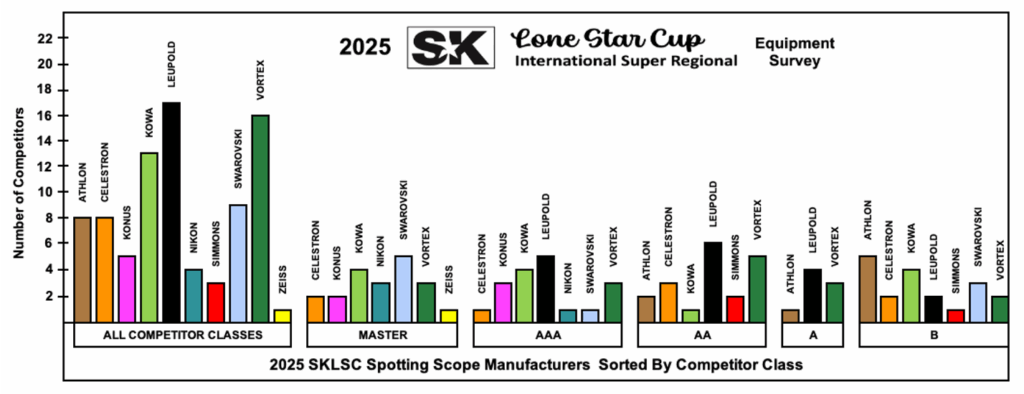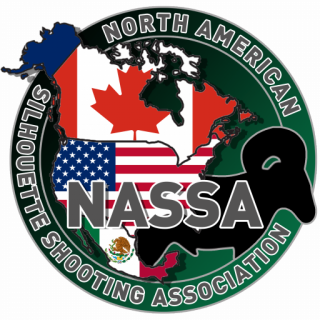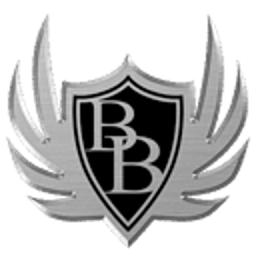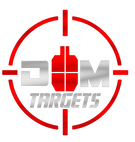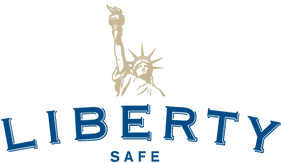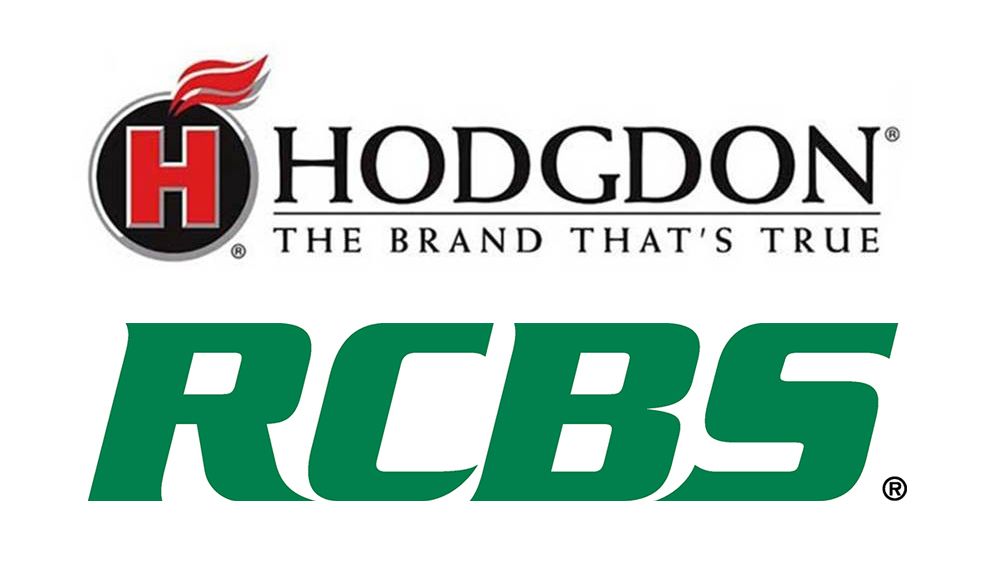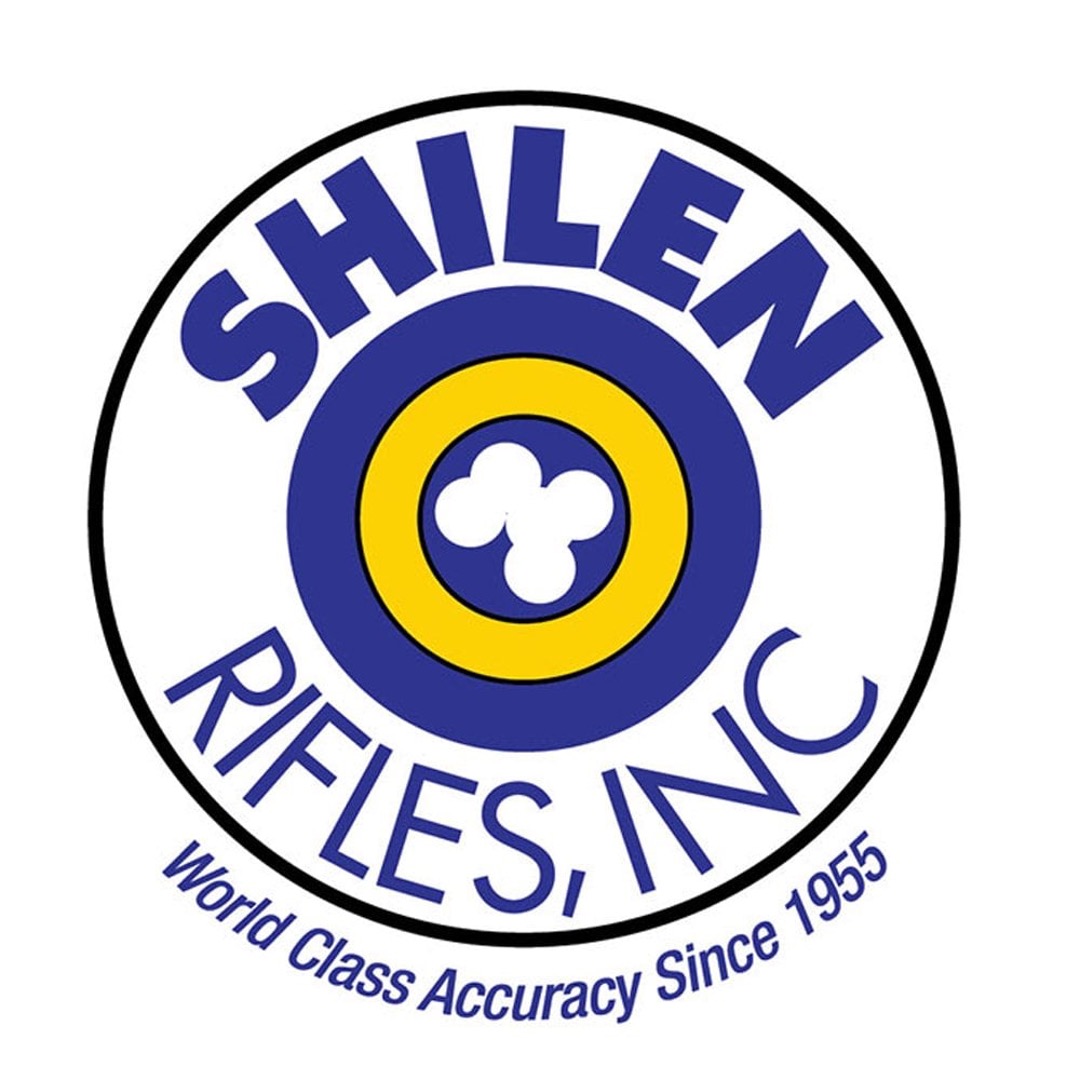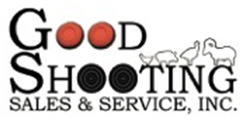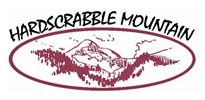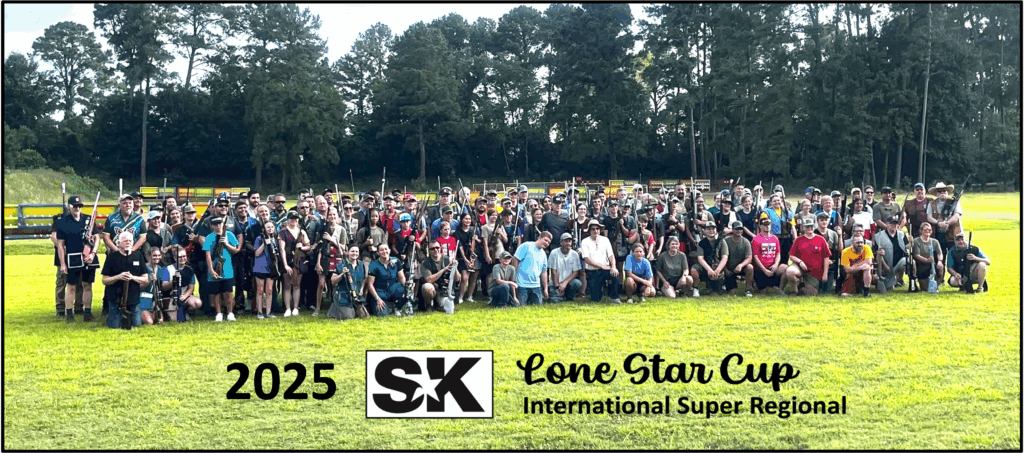
2025 SKLSC Equipment Survey
The 2025 SKLSC Equipment Survey Information presented below was collected from competitors in our Smallbore Silhouette Standard Rifle discipline. Benchrest Rifle Silhouette is not included here as it is too new a discipline with only 25 participants…..too few to get a meaningful sample of data. Note – Survey data may not be totally complete in all cases as we can only rely on what was filled out (or not) by each competitor.
Our goal was to use 2025 SKLSC Survey Data to discuss equipment trends & potential recommendations for new & junior shooters. We also intend to use future SK Lone Star Cups to further study silhouette equipment trends for:
- New product technology utilization (rifles, actions, barrels, scopes and ammunition).
- Marketshare information for our shooting sports sponsors to continue building prize donation relationships.
- Performance information for shooting sports equipment manufacturers to aid in product improvement & new product development.
Equipment Trends & Recommendations for New & Junior Shooters
Experienced silhouette veterans are often asked by new and junior shooters what rifles and equipment they should buy to compete in our various silhouette disciplines. This is never really a short answer on what rifle & equipment components are optimum, readily available and affordable to meet individual needs.
An optimized silhouette rifle is built using a “System Approach”, made up of a set of components that are interconnected, interdependent and work together to optimize a shooter’s ability to reach their stated goals. We can define the silhouette rifle’s major components as the (1) action, (2) trigger group, (2) barrel, (3) stock and (4) scope/rings.
Thinking about changing out one major component can have a negative impact on another interdependent component. Interdependency can have both performance and/or cost consequences if not thought about before making decisions on switching components. For example, switching from an Anschutz action will probably prohibit you from using your favored Anschutz trigger on the new action.
It is my hope that the following 2025 SKLSC Survey Results gives our new and junior shooters some insights what our veteran silhouette shooters use. More information will be generated in the months to come within the NASSA Technical Library. One final note is that the survey data form was filled out by each competitor and data shown does not take into account that some rifles were shared between some competitors.
Smallbore Silhouette Rifle Actions Survey Data
The 2025 SKLSC Smallbore Rifle Actions vs. the Competitor Class & Category survey data is shown in the (2) graphs below. It should be no surprise that Anschutz (1712 & 54.18 models) has been and will continue to be the predominant premium actions used in silhouette for Master Class as well as experienced adult and senior competitors in AAA, AA and A classes.
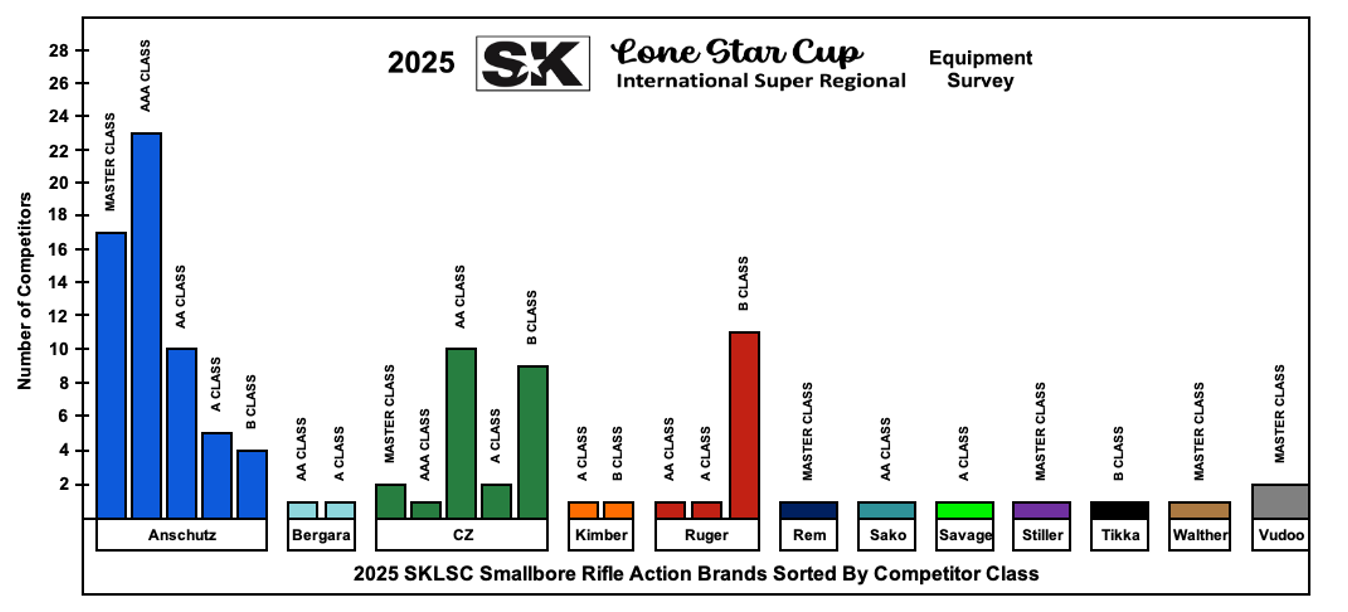
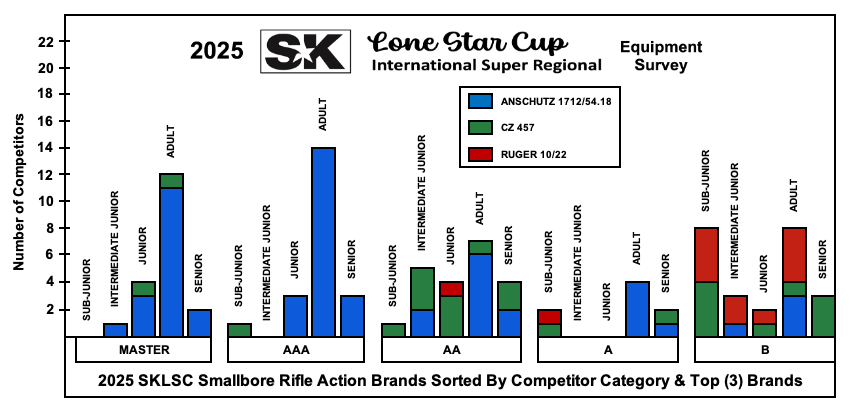
What is interesting is the rise of CZ as a growing contender in the overall silhouette rifle marketshare. Much of this is due to CZ models such as the CZ 457 American with good performance balanced against exceptional value at complete rifles under $700 out of the box. For example, you can see that CZ is the dominant rifle used by Juniors in the “AA Class” at the 2025 SKLSC.
The case for the CZ 457 only gets stronger when you consider that Jake Stine won (2) North American Lapua Monarch Cup Championships with a CZ 457 barreled action bedded on a Merrier stock! Aidan Cole is another outstanding example of a Master Class shooter who went through his Louisiana Junior 4-H program with a CZ rifle. At this price point, a young junior shooter can better afford to start with a CZ and continue to compete with it even as a Master Class shooter. On a side note, CZ-USA donated a CZ457 American Rifle to our 2025 SKLSC Junior Prize Table. Liam Herrera, Mario Herrera’s 6-year old son and youngest competitor won the rifle, so looks like we have another CZ convert for the 2026 SKLSC!
We also collected some interesting data after recruiting Louisiana 4-H kids, parents and coaches who had never shot in an NRA Registered or Club Silhouette match. All their NRA classifications were earned at the 2025 SKLSC by taking the scores from Saturday’s results and using them for the Grand Aggregate on Sunday. The make-up of these “Unclassified Shooters” consisted of (11) Sub-Juniors, (1) Intermediate Junior, (5) Juniors, (5) parents and (2) 4-H Coaches. Their silhouette action selection was also interesting at (11) Ruger 10/22’s, (7) CZ’s, (2) Bergara’s and (1) Tikka, with the Ruger 10/22 being the dominant rifle in the “B Class”.
When I inquired about the Louisiana 4-H use of the Ruger 10/22, this is largely driven by their participation in the CMP Rimfire Sporter Event where the gun must meet a 7 lb.- 2. oz. weight limit and a 2 1/2 lb. trigger. The Ruger 10/22 is relatively inexpensive and the accuracy requirements for this CMP event are not as tough as the 4-H 3-Position and Silhouette disciplines. As more 4-H Juniors wish to excel in NRA Silhouette Registered or Club Matches, buying or upgrading to a rifle such as the CZ 457 American in these early formidable years will be much to their advantage.
The 2025 SKLSC data also shows (1) Stiller action and (2) Vudoo actions were used by Master-Class shooters. We will continue to see MORE “custom .22lr action manufacturers” in Silhouette as we track SKLSC survey data in the years ahead. This is largely being driven by stronger demand in other smallbore shooting disciplines such as the Precision Rifle Series. Desert Precision Gunworks LLC, a custom rifle builder & Lapua Monarch Cup donor, is one example with their new .22lr action product launch that I am personally looking forward to testing!
Smallbore Silhouette Rifle Barrels Survey Data
The 2025 SKLSC Smallbore Standard Rifle Barrels vs. Competitor Class data below compares the use of factory barrels over custom barrel brands used at our match. As you might expect, custom rifle barrels are more prevalent in Master Class shown in the graph shown below. Older veteran shooters in the AAA, AA, A Classes are also more apt to have custom barrels as they usually have had their rifles for some time.
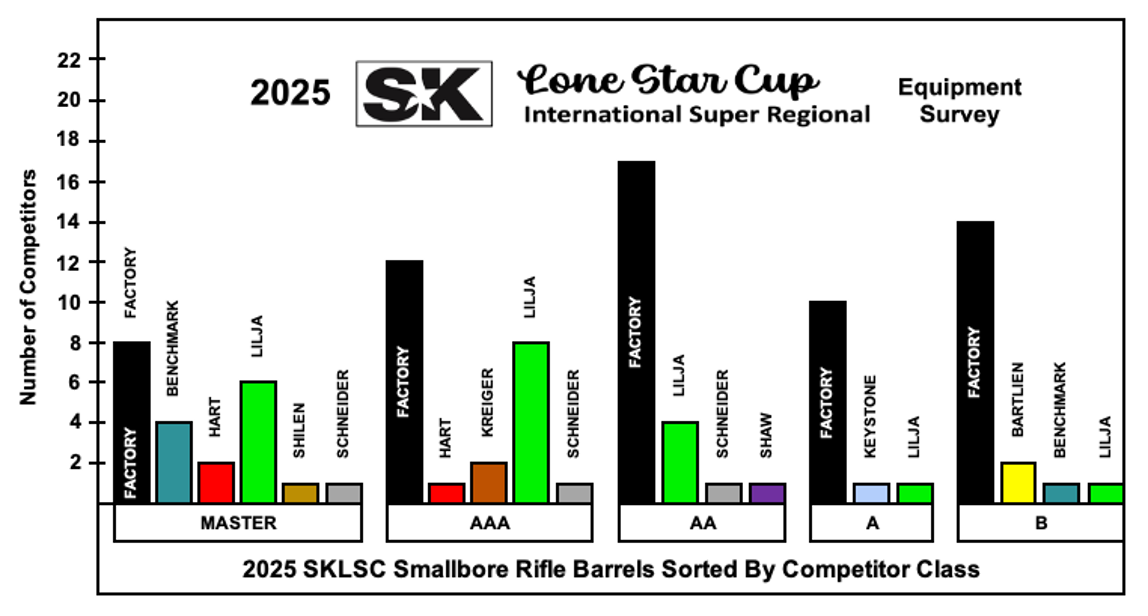
Most factory barrels are capable of tens of thousands of rounds down range before they wear out as compared to silhouette highpower barrels IF YOU TAKE CARE OF THEM. The decision to replace a factory barrel comes down to a cost/benefit decision. Does the barrel swap solve an identified problem, giving you a specific performance edge that benefits your potential? Often, this can also have a psychological benefit if this gives you more confidence in your equipment.
A typical performance issue (or opportunity) might be the ability for the rifle to consistently and accurately group out to 100 meters with the right ammo combination. Another personal example is I tested and chose a Lilja custom barrel over my Anschutz factory barrel to successfully eliminate “first shot flyers”.
You will recognize many of the custom rifle barrel makers in the graph above such as Benchmark, Hart, Lilja, Shilen And Schneider. All these barrel makers have good reputations from shooting disciplines such as smallbore benchrest, smallbore prone, etc. and are capable of delivering the accuracy required for smallbore silhouette. Just be sure you known what your goals and expectations are as well as having a competent gunsmith properly chamber, crown, assemble the barrel into the action.
Smallbore Silhouette Rifle Stocks Survey Data
The 2025 SKLSC Smallbore Standard Rifle Stocks vs. Competitor Class data is shown in the graph below. Note that the 2025 SKLSC was purposely made a Silhouette Standard Rifle Match ONLY so many of our Mexican competitors could import their own Standard Rifles into the USA to compete. There is no Hunter Class in Mexico.
Many USA & Canadian shooters use their Hunter Rifles to compete in Standard Rifle class so they do not have to shoot (2) different rifles in a silhouette match requiring both rifles classes. The choice to do so can be performance related (train with only one rifle), cost related or both. For a new or junior shooter just starting out, an NRA legal Hunter Rifle is a good cost-effective choice.
When discussing silhouette stocks, this is another reminder that the “Silhouette Rifle System” is made up of three major components, the (1) barreled action, (2) stock and (3) rifle scope. The Silhouette Rifle System is bound to specific NRA configuration rules that govern stock geometry, barrel taper, maximum weight and trigger pull weight
The Anschutz 1712 and CZ 457 American out-of-the-box factory rifles with wood stocks that do conform to the NRA Hunter Rifle rules for overall stock geometry, 9 lbs. maximum weight and capable of a 2 lb. minimum trigger pull.
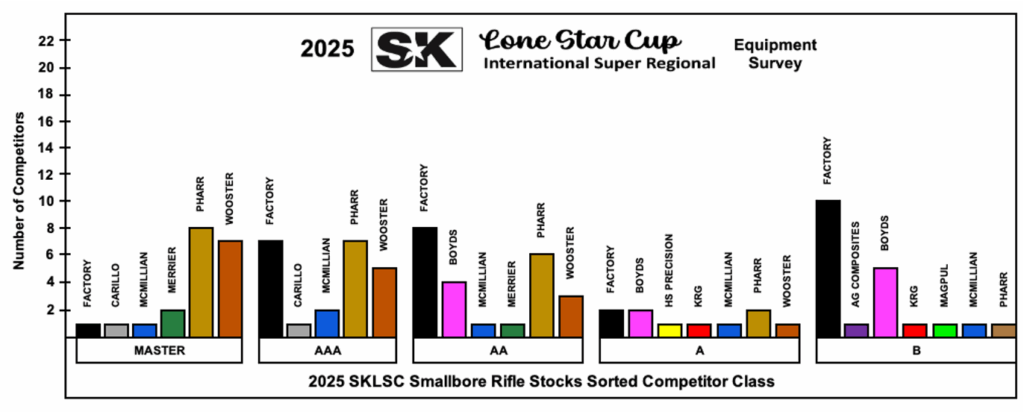
So why do so many Master and AAA shooters have Pharr, Carillo (copy of Pharr), Wooster, Merrier or McMillian stocks on their Anschutz or CZ brand rifles and/or actions? The short answer is these stocks offer better ergonomic features and lighter fiberglass or carbon fiber materials for weight savings. Ergonomic features such as a higher cheek comb for better upright head placement compared to factory stocks is one exmple. With the lighter material weight savings, that means you can better optimize weight distribution for the standing position, such as increasing barrel weight distribution.
Pharr stocks, made by Robertson out of Canada are no longer made, but can be found on many used rifles for sale and are highly sought after. Steve Wooster (Washington State) makes a fine carbon fiber stock, but can have a back-log of orders. While silhouette stock demand may not constitute a large commercial volume, there is a small niche market opportunity for a new supplier. There are quite a few new synthetic stock makers now out there that are possible candidates such as Pure Precision and AG Composites. Both these stock suppliers were donors to the SK Lone Star Cup Prize Table and make stocks with aluminum pillar bedding inletted for Remington 700-type and CZ actions.
Smallbore Silhouette Rifle Scopes Survey Data
The 2025 SKLSC Smallbore Standard Rifle Scopes vs. Competitor Class survey data is shown in the graph below. As one might expect, Leupold scopes (shown in black below) dominated in Master & AAA class. This included obsolete models such as the Leupold VX-3 6.5-20, Leupold FX3 (25x), FX3 (35X) along with the newer “limited production” run of the Leupold VX-3HD 6.5×20 (diamond reticle). Most favored reticle is a crosshair with a 3/8 or 1/2 minute dot.
“Boosted” Leupold scopes (shown in gray below) were once very popular and offered by Premier Reticle that increased magnification to 18x35x or 18x40x with the addition of a rear “optical booster”. Unfortunately, these old scopes are eventually losing their windage/elevation tracking capability and will also fail in time due to elastomer seal deterioration.
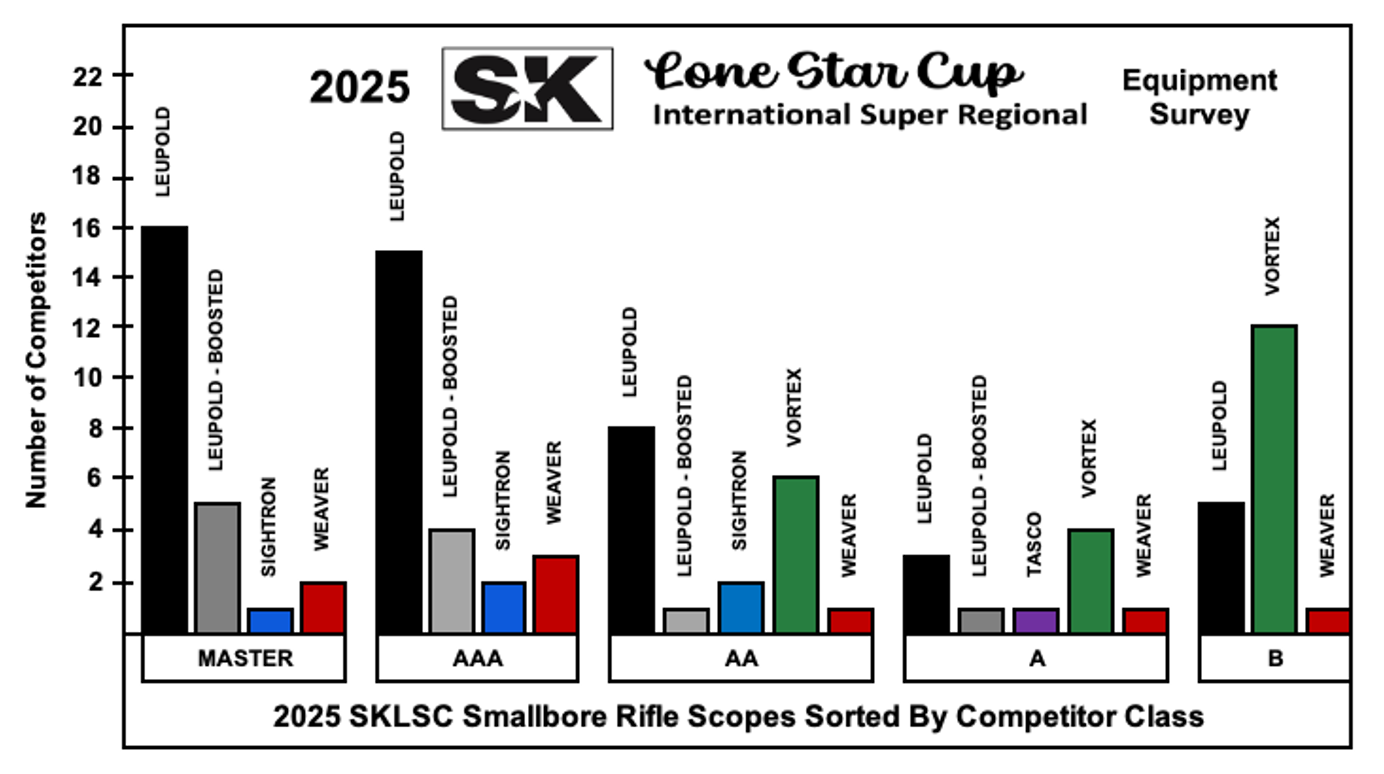
Sightron (shown in blue above) once made a Big Sky Silhouette 6-24x scope that was popular with many silhouette shooters and is represented in the Master, AAA and AA data above. Weaver (shown in red above) is another old veteran brand with their T-10 Series in various powers that used to be the Gold Standard many years ago.
Vortex Optics (shown in green above) is the relative newcomer to our silhouette discipline as shown in the AA, A and B classes. What is interesting is that of the 22 competitors using Vortex Optics scopes, the age make-up is 10 Sub-Juniors, 4 Intermediate Juniors, 4 Juniors and 4 Adults. All the juniors are mostly made up of 4-H Juniors from Louisiana. While Vortex Optics scopes do not feature favored crosshair/large dot reticle, a favorite among the Louisiana 4-H Silhouette Community is the Vortex Crossfire II 6-18X44AO crosshair/small dot reticle that can be illuminated. Vortex rifle scopes are very good quality, readily available and at a favorable price point for the 4-H Shooting Sports Program. We are also happy to have Vortex Optics as a major sponsor/donator to our SK Lone Star Cup Prize Table. Thanks Vortex Optics!
The comments above show that we have a recent scope manufacturing void for “the ideal silhouette scope” to satisfy many of our advanced silhouette shooters. At one time, the number of silhouette shooters was much greater, commercially justifying the manufacture of specific scopes geared to our specific silhouette requirements.
Ideal can be defined as a commercial silhouette scope with the right power, reticle and weight to satisfy 80%+ of the silhouette community. Many of the scopes produced today are geared towards the “tactical shooting sports” such as PRS. These new scopes typically have 30mm tubes that increase scope weight, not ideal for the maximum weight restrictions we have on the Smallbore Silhouette Hunter Rifle. We did get a little relief with the NRA Smallbore Hunter Rifle weight limit rule changing from 8.5 lbs. max to 9.0 lbs. max. This means that the 1/2 lb weight increase can be used to compensate for a heavier modern scope, a heavier stock weight (nice grain wood?) or both.
Many tactical reticles are also “too busy” and not optimum for the typical silhouette shooter. There are efforts by some within our silhouette community to work with select scope manufacturers to build a more suitable silhouette scope(s) for us. We will see how that develops…..
Smallbore Silhouette Ammunition Survey Data
The 2025 SKLSC Ammunition Manufacturers Represented & Sorted By Competitor Class survey data is shown in the (2) graphs below. It should be no surprise that our Title Sponsor, SK Ammunition, combined with the Lapua offerings (Capstone Precision Group) represents the largest marketshare percentage at 65%. Their next biggest competitor, ELEY, comes in at 22% followed by a mix of brands at 13%.
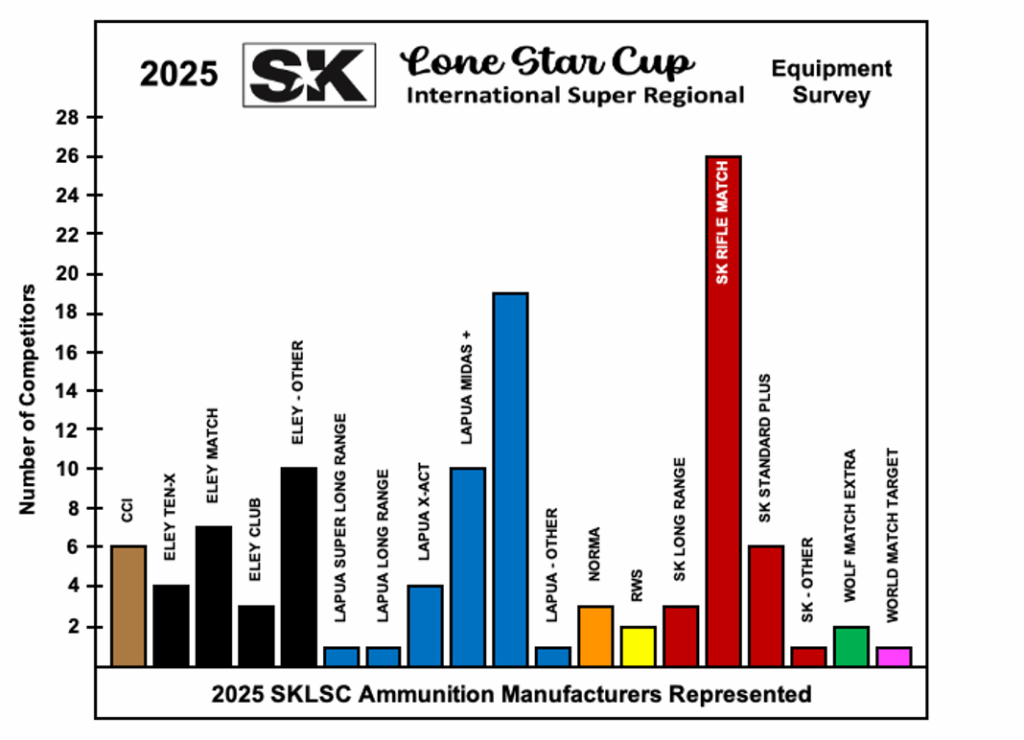
What is more relevant and important in this graph below is that SK & Lapua ammunition combined represents an 87% marketshare among the Master Class shooters with Eley coming in at 13%. The reason for this is due to performance accuracy required to compete in the Master Class and even into the AAA Class. As new and junior shooters progress from B, A and AA Class, there is a point in time where their increasing ability should be paired with the better preforming ammunition such as SK or Lapua. We are most grateful in the support SK Ammunition lends to or silhouette community!
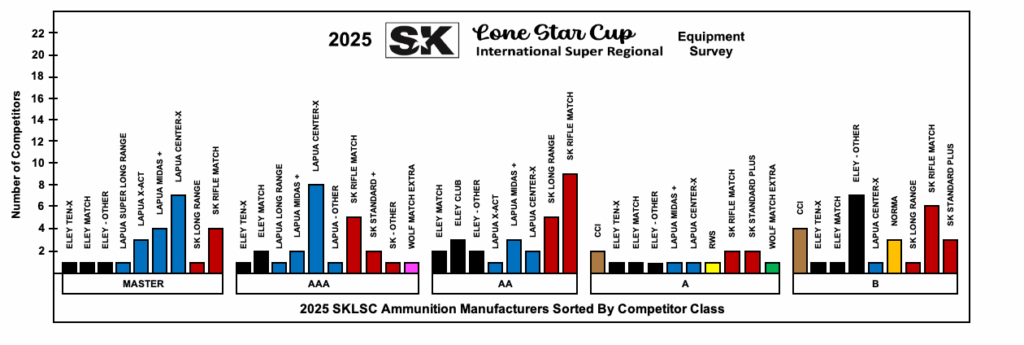
Spotting Scope Manufacturers Survey Data
The 2025 SKLSC Spotting Scope Manufacturers data sorted by competitor class is shown in the graph below. The silhouette spotting scope brands run the entire gambit from expensive to relatively inexpensive scopes. For the purpose of smallbore silhouette (out to 100 meters), one could generalize that all brands shown below would meet the minimum spotting requirements. For someone on a budget and staring out in silhouette, money is probably better spent on a good rifle.
Where better quality spotting scopes could make a difference is for High Power Silhouette (out to 500 meters). Here, the quality of the lenses and a larger 80mm objective (verses 60mm) results in a better light gathering capability, brighter image and thus a greater ability to spot a shot (such as early in the morning) at greater distances. If you plan on shooting both Silhouette Smallbore & High Power disciplines, give this some thought.
Scope brands such as as Kowa (Japan) and Swarovski (Austria) have excellent optics that are comensurate with their retail cost. Konus, Athlon and Vortex Optics do offer some lower-tier scope models with a lower price point for entry-level silhouette shooting. You can see that many of these lower cost spotting scopes in the graph below have increased their total marketshare since their introduction. For the budget minded, this works for smallbore silhouette with limited funds better spend on a rifle and/or rifle scope upgrade!
